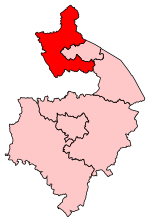Hams Hall power stations
Buildings and structures in WarwickshireCoal-fired power stations in EnglandPages containing links to subscription-only contentPower stations in the West Midlands (region)Use British English from March 2014

Hams Hall Power Station refers to a series of three, now demolished coal-fired power stations, situated in Warwickshire in the West Midlands of England, 9 miles (14 km) from Birmingham.
Excerpt from the Wikipedia article Hams Hall power stations (License: CC BY-SA 3.0, Authors, Images).Hams Hall power stations
Faraday Avenue, North Warwickshire
Geographical coordinates (GPS) Address Nearby Places Show on map
Geographical coordinates (GPS)
| Latitude | Longitude |
|---|---|
| N 52.524608 ° | E -1.705175 ° |
Address
Faraday Avenue
Faraday Avenue
B46 1AL North Warwickshire
England, United Kingdom
Open on Google Maps





